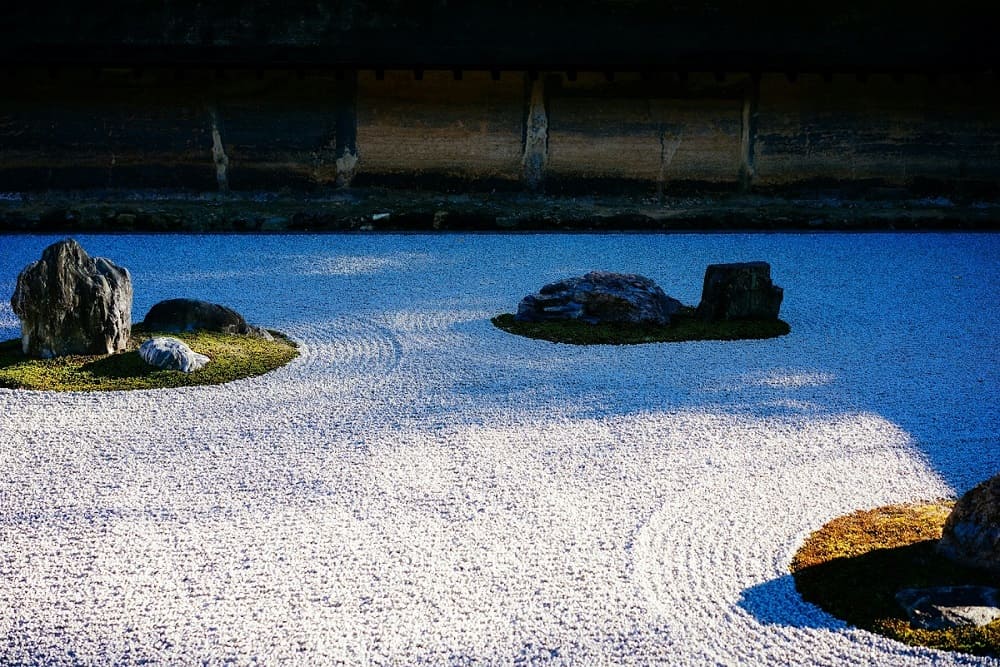Karesansui, also known as Japanese dry landscape gardens, is one of Japan’s most iconic forms of garden design. These unique spaces capture the essence of nature without using actual water, instead relying on stones, gravel, and sand to symbolize landscapes like rivers, oceans, or mountains.
Karesansui gardens are deeply tied to Zen Buddhism, often found in temples as spaces for meditation and reflection. They represent simplicity, balance, and the profound beauty of minimalism. In this article, we’ll explore the origins of Karesansui, famous gardens to visit, and even its appearance in Nioh 2.
What is Karesansui?


Karesansui is so beautiful!!

I like Karesansui, too….
I’d love to have Karesansui in my front yard sometime soon…

Yamanba! What are you doing here? Please go back to the mountains where you belong!

Sorry, dear, I came to see Yanagi Baba today. She lives near in one of your Yanagi Trees!

That is shocking!

Yes! It is, we need to get rid of her and Yamanba without harming the Yanagi tree
The Basics of Karesansui

Karesansui gardens use no water. Instead, they feature stones and gravel arranged to recreate the beauty of natural landscapes. The white gravel often represents water, while the stones symbolize islands, mountains, or other natural features. The designs are meticulously crafted to evoke calm and inspire introspection.
This minimalist style emphasizes the concept of “wabi-sabi,” the appreciation of imperfection and transience, which is central to Japanese aesthetics.
The Origins of Karesansui

The origins of Karesansui can be traced back to the Muromachi period (1336–1573) in Japan. Influenced by Zen Buddhism, these gardens were created as aids for meditation. Monks would rake the gravel into patterns resembling waves or flowing water, encouraging deep contemplation and a connection with nature.
Over time, Karesansui evolved into an art form, blending spiritual philosophy with aesthetic sensibilities.
What Makes Karesansui Unique?

Unlike traditional gardens with lush greenery and water features, Karesansui focuses on abstraction and symbolism. The lack of water and plants allows the viewer to use their imagination to complete the scenery.
The carefully placed stones and raked gravel create a visual harmony that changes depending on the viewer’s perspective, making each visit to a Karesansui garden a unique experience.
Famous Karesansui Gardens


There are some famous gardens for Karesansui.
Ryoan-ji Temple (Kyoto)

The Karesansui garden at Ryoan-ji Temple (龍安寺) is perhaps the most famous in Japan. Its mysterious layout of 15 stones placed amidst a sea of raked gravel has puzzled and inspired visitors for centuries. No matter where you stand, at least one stone is always hidden from view, symbolizing the incompleteness of human perception.
Daitoku-ji Zuiho-in Temple (Kyoto)

Another must-see Karesansui garden is at Daitoku-ji.
Especially Zuiho-in, also part of the Daitoku-ji complex, is particularly notable for its modern interpretation of Karesansui. It combines traditional design with innovative elements, making it a favorite for both traditionalists and contemporary art lovers.
Karesansui in Nioh 2



Karesansui gardens even make an appearance in the action-packed video game Nioh 2. The game incorporates Karesansui as a backdrop, adding a serene yet eerie atmosphere to its levels. Players can admire the artistry of these dry landscapes while navigating intense battles, showcasing how this traditional art form continues to inspire modern media.
Karesansui Q&A

- QCan Karesansui gardens be found outside of temples?
- A
Yes! While many are located in Zen temples, some modern interpretations of Karesansui can be found in public parks, private homes, and even museums.

For example, 足立美術館 is famous for Karesansui!
- QCan I create a Karesansui garden at home?
- A
Absolutely! With a few stones, some gravel, and a rake, you can design a small-scale Karesansui garden in your backyard or even in a tabletop version for indoor use.

I’m interested in Karesansui plate!
If you like cooking, check the plate below.
This store “Rakuten Ichiba” has global express service.

So you can enjoy shopping from anywhere!
Conclusion

Karesansui gardens are more than just beautiful landscapes; they are reflections of Japan’s deep cultural and spiritual traditions. Whether you visit a historic site like Ryoan-ji or encounter a modern depiction in media like Nioh 2, Karesansui invites you to pause, reflect, and appreciate the beauty of simplicity.
Next time you’re in Japan, be sure to experience the tranquility of a Karesansui garden in person. It’s a journey into the heart of Japanese aesthetics that will leave a lasting impression.

If you are interested in Japanese culture, you may love these games!
Let’s play!

Yes! Let’s play NIOH games!

![[商品価格に関しましては、リンクが作成された時点と現時点で情報が変更されている場合がございます。] [商品価格に関しましては、リンクが作成された時点と現時点で情報が変更されている場合がございます。]](https://hbb.afl.rakuten.co.jp/hgb/43eb5a36.f4baaa30.43eb5a37.6ed762da/?me_id=1232575&item_id=10008572&pc=https%3A%2F%2Fimage.rakuten.co.jp%2Ftablewareshop%2Fcabinet%2Fkaden%2Fkaresansui-img.jpg%3F_ex%3D240x240&s=240x240&t=picttext)



Comments